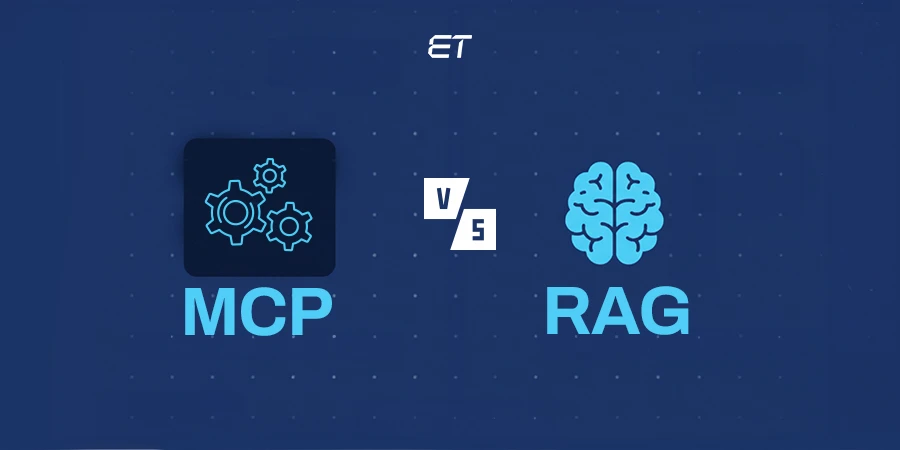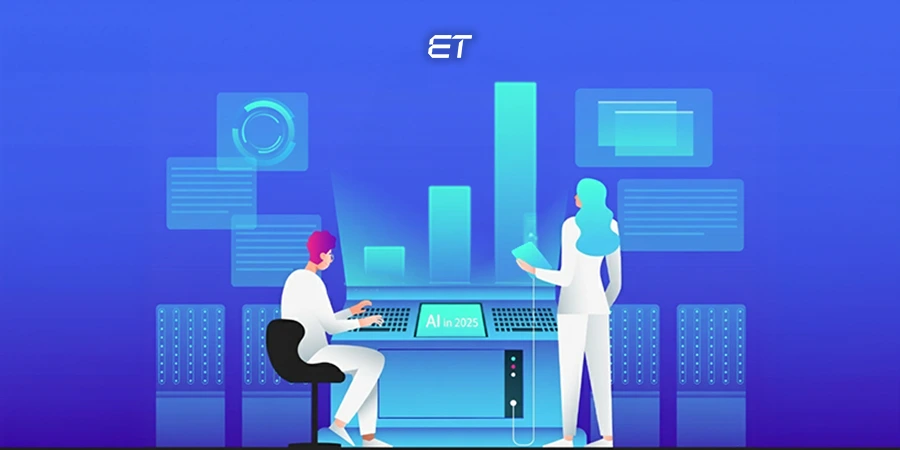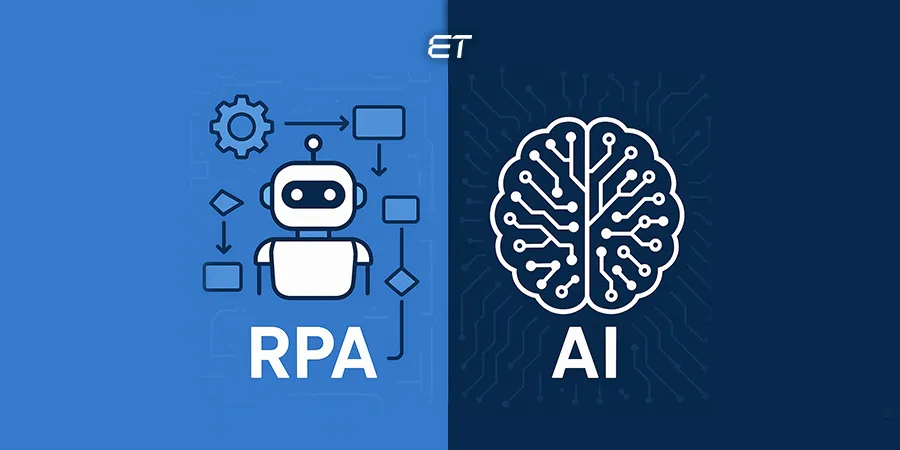
RPA vs AI: The Real Difference and Where Each Fits in Enterprise Operations
Key Takeaways:
- RPA vs AI serve different roles- RPA handles structured, rules-based execution, while AI interprets, analyzes, and makes decisions.
- The highest value is achieved by combining both, enabling intelligent, end-to-end automation across enterprise workflows.
- RPA delivers stability and fast ROI, especially in repetitive back-office tasks and legacy environments.
- AI is essential for processing unstructured data, predicting outcomes, and enhancing decision-making at scale.
- 2025 marks the shift from pilots to enterprise-wide automation, driven by GenAI and agentic AI systems.
- Data quality and governance remain the primary barriers, limiting the maturity of automation and the reliability of models.
- AI is evolving from a support tool to a strategic capability, reshaping how enterprises operate, forecast, and innovate.
In January 2025, a Gartner update shook the enterprise automation world: “More than 40% of agentic AI projects will be abandoned by 2027 due to unclear ROI, cost overruns, and governance gaps.”
This was not a prediction meant to discourage innovation. It was a reality check, particularly for CEOs and CIOs who had rushed into generative AI pilots in 2023 and 2024 without a clear execution or governance roadmap in place.
The message was clear: AI is powerful, but without structure, strategy, and alignment, it becomes an expensive experiment.
The report also reignited a question enterprises have struggled with for years: Should we prioritize RPA (Robotic Process Automation)? Should we go all-in on AI? Or do we need both?
2025 is the first year where the answer is obvious but requires a deep understanding of how these technologies, RPA vs AI, complement each other, how they differ, and how they must be orchestrated to deliver real transformation at the enterprise scale.
The Automation Landscape: RPA and AI Enter a New Phase
Before comparing RPA vs AI, it’s essential to consider the broader context. Automation in 2025 is not what it was in 2019 or even in 2022. The maturity curve has shifted dramatically. Generative AI tools have become part of everyday knowledge work.
Intelligent automation platforms have expanded their capabilities. RPA providers have integrated low-code AI components. Business users are more confident in automation than ever before.
Yet despite this progress, the two automation technologies continue to solve fundamentally different categories of problems, something leaders often overlook when treating both as interchangeable.
What RPA Actually Is in an Enterprise

Robotic Process Automation automates structured, repetitive tasks by following explicit rules and procedures. It does not think, infer, or interpret. It executes.
That execution may involve clicking through screens, scraping information from legacy systems, performing reconciliations, or moving structured data from one application to another. RPA behaves like a digital worker that never tires, never improvises, and never deviates from its script.
This predictability explains why enterprises continue to rely heavily on RPA, despite the rise of AI. Back-office operations such as finance, HR, procurement, IT service management are filled with processes that simply need discipline, speed, and accuracy, not creativity or cognition. RPA handles them exceptionally well.
If you’re curious about how fast AI adoption is accelerating in enterprises and what’s driving it, check out our in-depth blog:
What AI Actually Is in an Enterprise?

Intelligence, especially in its modern form, encompasses machine learning, natural language processing, and generative AI, which does something RPA vs AI can never: It interprets.
AI is designed to analyse patterns, make predictions, understand context, classify information, and generate content. It excels when data is unstructured or ambiguous, such as emails, PDF documents, customer conversations, medical notes, legal contracts, images, and sensor data.
AI does not follow rigid scripts. Instead, it produces probabilistic outputs. It evolves. It adapts. It improves. And because of this, AI handles tasks that require judgment, reasoning, or insight, tasks that RPA could never do.
Why Enterprises Still Choose RPA – The Case for Stability and Precision
Despite the burst of hype around AI, RPA remains the dominant force in enterprise automation for a simple reason: it delivers results quickly and consistently.
Many enterprise processes do not require advanced cognition; they simply require accuracy, reliability, and the ability to integrate with existing systems that will not be replaced anytime soon.
RPA’s Strengths in a Modern Enterprise
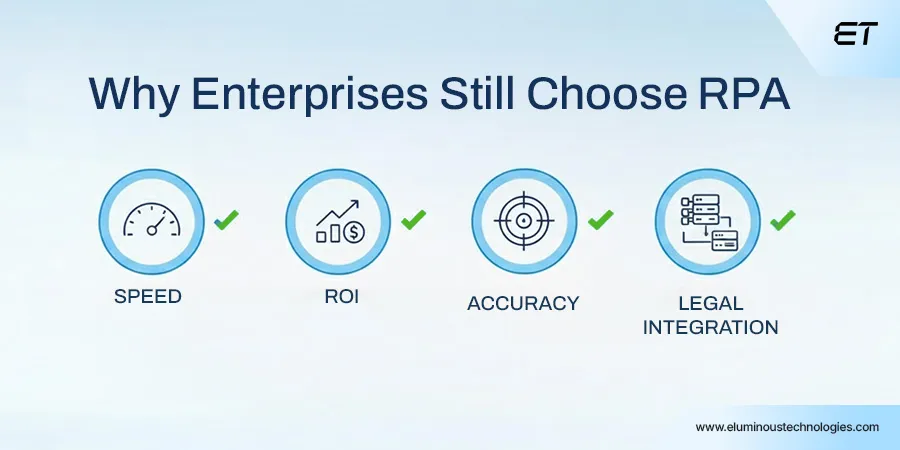
RPA offers several strategic advantages that continue to make it a favourite among COOs, CFOs, and operational leaders:
- It does not rely on large volumes of high-quality data.
- It substantially and predictably reduces manual workload.
- It delivers fast ROI, often within one or two fiscal quarters.
- It fits naturally within governance frameworks because its behaviour is explainable and auditable.
- It interacts seamlessly with legacy systems that do not support modern APIs or AI integrations.
This is particularly appealing in industries such as banking, healthcare, insurance, and telecommunications, where a significant portion of daily work involves structured workflows.
Enterprise Examples
A large healthcare network in the United States demonstrated the significant impact of RPA when applied to high-volume, rules-based administrative tasks.
IU Health, one of the country’s largest integrated healthcare systems, used RPA to automate its patient registration and pre-registration workflows, a process that previously required extensive manual effort across multiple systems.
With automation in place, the organization now processes nearly 300,000 appointments every month, while reducing the average registration time from 3.4 minutes to just 2.5 minutes per patient.
This improvement not only accelerated throughput but also significantly reduced administrative burden for front-office teams, enabling staff to redirect their time toward patient-facing interactions rather than repetitive data entry.
Looking to understand the architectural shift from basic automation to fully autonomous AI systems? Agentic AI Frameworks will help you navigate this emerging landscape with clarity.
Why AI Has Become Indispensable – The Case for Intelligence and Interpretation
If RPA handles execution, AI handles interpretation. In 2025, the amount of unstructured data generated by enterprises has reached a point where manual processing is neither viable nor scalable.
Emails, customer chats, compliance policies, scanned contracts, product reviews, medical reports, and enterprise knowledge assets require reading, classifying, and contextual understanding.
AI’s Unique Strengths
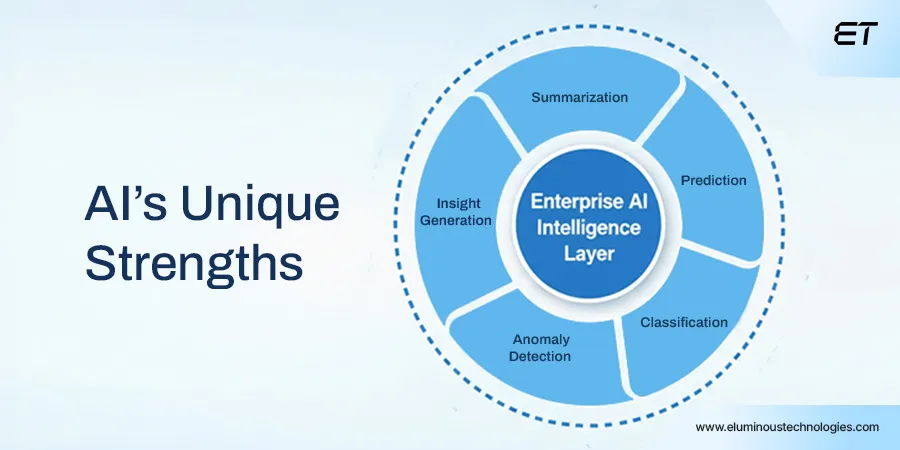
AI brings capabilities that RPA simply cannot match:
It can read and understand documents.
It can summarise large volumes of content.
It can identify risks or anomalies in financial transactions.
It can recognise patterns in customer behaviour.
It can predict demand, churn, or fraud risk.
It can generate responses, reports, or insights based on context.
In short, AI enhances enterprise decision-making by bringing intelligence to workflows that were previously purely manual and judgment-driven.
Real Enterprise Examples
A leading American bank used AI to solve one of its largest operational bottlenecks: processing 35 million loan applications and supporting documents accumulated across multiple acquisitions.
Rather than relying on manual teams, the bank deployed an AI-driven classification system that automatically sorted documents into 275 predefined categories. Within just two weeks, the AI processed the entire backlog of work that would have taken months for humans to complete.
The results were substantial: operational costs decreased by 50%, document classification accuracy increased to 87%, and critical workflows, ranging from compliance checks to customer onboarding, became significantly faster and more reliable. This case illustrates how enterprise-scale AI can rapidly transform traditionally labor-intensive processes into streamlined, cost-effective operations.
Why the “RPA vs AI” Debate Is Misleading in 2025

Many enterprise leaders still treat RPA vs AI as competing technologies. In reality, they operate in completely different layers of the automation stack. They are not rivals—they are collaborators.
RPA Alone Cannot Deliver Cognitive Automation
RPA has become a proven workhorse for repetitive, rules-based tasks; however, its limitations become evident the moment a process requires any form of interpretation or adaptability. RPA breaks down when:
Data is unstructured.
Input formats vary.
Exceptions are frequent.
Interpretive reasoning is needed.
Processes change rapidly.
RPA is powerful but rigid. It requires stability.
AI Alone Cannot Execute Enterprise Workflows
On the other hand, AI excels at understanding and analyzing information, but it lacks the native capability to perform actual system-level actions. AI cannot:
- Log into systems.
- Perform multi-step ERP updates.
- Move data between platforms.
- Trigger approvals.
- Reconcile numbers between multiple databases.
- AI requires an execution engine to implement its decisions in the real world.
The Most Successful Enterprises Use Both
In 2025, the most mature enterprises have stopped debating RPA vs. AI and started designing automation ecosystems that seamlessly orchestrate both technologies. This is known as Intelligent Automation, representing the future of enterprise operations.
The pattern is consistent:
AI interprets.
RPA executes.
The combination produces an exponential value.
The RPA Vs AI Barriers Enterprises Must Overcome to Scale Automation in 2025
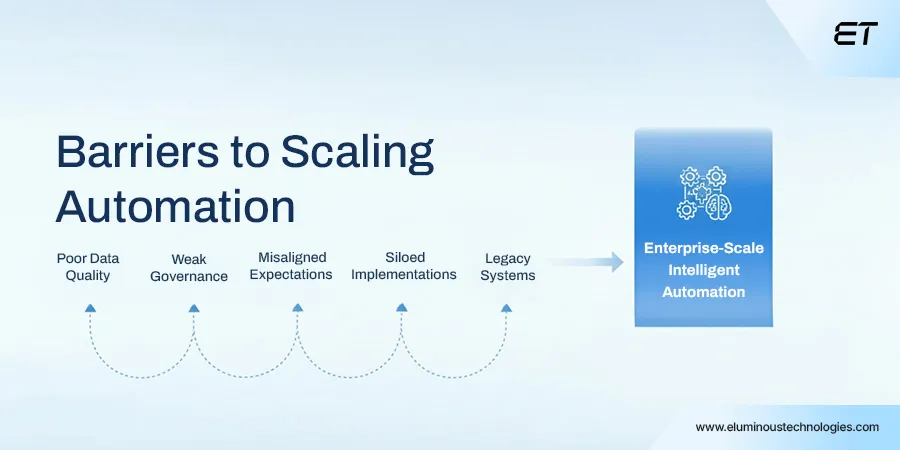
Despite the growing success stories, automation still encounters significant roadblocks in enterprises:
1. Poor Data Quality
AI models cannot perform consistently without clean, reliable, structured data. Many enterprises still struggle with fragmented data silos, inconsistent formatting, and missing metadata.
2. Weak Governance
Without proper guidelines around transparency, model monitoring, ethics, and responsible use, AI outputs may create legal, reputational, or compliance risks, especially in regulated industries.
3. Misaligned Expectations
Executives today often expect AI to deliver immediate, transformative results. In reality, among RPA vs AI, AI requires training cycles, fine-tuning, testing, and validation before it becomes reliable enough for enterprise use.
4. Siloed Implementations
When RPA is run by operations, AI by data science, and digital transformation sits elsewhere, automation remains fragmented and weak. Companies require cross-functional governance to achieve meaningful scale.
5. Legacy Infrastructure
AI thrives on connected, modern data architectures. Legacy systems, outdated integrations, and manual dependencies limit AI’s ability to contribute.
Choosing the Right Path: RPA or AI?
Choosing between RPA vs AI is not about which technology is more advanced; it’s about understanding the unique benefits of each. It is about understanding the nature of the work you want to automate.
- If the task is repetitive, structured, rules-driven → RPA is the right fit.
- If the task involves interpretation, unstructured data, judgment, or prediction → AI is the right fit.
- If the task requires both thinking and doing → don’t compare RPA vs AI, use both.
The decision framework becomes simple once leaders stop comparing the technologies and start evaluating their workflows objectively.
Want to understand how intelligent AI agents enhance enterprise automation? Explore Agentic AI Frameworks to see how reasoning, memory, and autonomous execution come together.
The Future of Automation Is Not RPA vs AI – It Is RPA + AI
2025 makes it clear that RPA vs AI were never meant to replace one another; they were meant to work together.
When combined, they don’t just automate tasks; they transform entire workflows, evolving operations into intelligent, connected, and continually improving systems.
Organisations that adopt this integrated approach will move faster, operate more efficiently, and remain resilient in an increasingly competitive market.
The real differentiator in the years ahead will be how effectively companies align strategy, data, governance, and technology to build automation ecosystems that scale.
For enterprises ready to take the next step, partnering with teams that truly understand intelligent automation, both the engineering and the strategy behind it, can accelerate the journey and ensure every investment delivers a measurable impact.
Frequently Asked Questions (FAQs)
1. Is RPA being replaced by AI?
No, AI is not replacing RPA. Instead, enterprises are combining both as complementary layers: AI handles interpretation; RPA handles structured execution.
2. Is AI better than RPA?
Neither is “better.” AI is used for cognitive tasks like prediction and understanding, while RPA excels at rule-based, repetitive work. The best choice depends on the workflow.
3. Does RPA come under AI?
No. RPA is a rules-driven automation technology, while AI is a cognitive system that learns and reasons. They are separate technologies that work well together.
4. What is the difference between RPA and an AI agent?
RPA follows predefined rules to execute tasks, while AI agents can interpret information, make decisions, plan steps, and adapt to changing inputs.
5. Can RPA vs AI work together?
Yes. RPA executes structured tasks, while AI adds decision-making and interpretation; together, they create end-to-end intelligent automation.
6. Which is more cost-effective: RPA vs AI?
RPA typically provides faster, lower-cost ROI, while AI delivers deeper long-term value by enhancing accuracy, insights, and decision quality.



